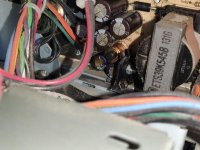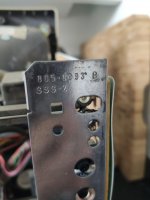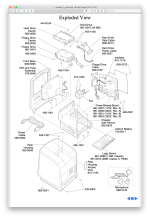benanderson89
Well-known member
Hi everyone.
I'm a complete newcomer to the world of classic macs and I recently bought two (sold as not working) compact classics for peanuts from an apple repair shop here in the UK. One was beyond saving (battery exploded, tube smashed) but had a sections of good parts inside (80MiB quantum, weird RAM board with Motorola SIMS) and a brilliant case. The second of the two computers had a brilliant motherboard with almost no corrosion, but the case was junk. So I'm trying to combine the two together to make one complete machine.
I've just finished recapping the motherboard and when performing a smoke test (with no RAM Board, no FDD and HDD connected), the speaker just makes a crackling sound that gets louder the longer the machine the left on (and if the machine was on previously, it'll become louder more quickly). I'm too nervous to leave it on for long enough to see if the tube warms up and generates an image (though I'm fairly certain it wont). Anything coming out of the speaker is a vast improvement as it previously showed no signs of life, but now I'm at a loss -- I know my way around Commodores but not a Compact Mac.
Any help would be fantastic. In the meantime I'll be removing the motherboard and giving it another clean with IPA just to be absolutely sure nothing funny is left on the board.
Thanks!
YouTube Video showing the issue.
I'm a complete newcomer to the world of classic macs and I recently bought two (sold as not working) compact classics for peanuts from an apple repair shop here in the UK. One was beyond saving (battery exploded, tube smashed) but had a sections of good parts inside (80MiB quantum, weird RAM board with Motorola SIMS) and a brilliant case. The second of the two computers had a brilliant motherboard with almost no corrosion, but the case was junk. So I'm trying to combine the two together to make one complete machine.
I've just finished recapping the motherboard and when performing a smoke test (with no RAM Board, no FDD and HDD connected), the speaker just makes a crackling sound that gets louder the longer the machine the left on (and if the machine was on previously, it'll become louder more quickly). I'm too nervous to leave it on for long enough to see if the tube warms up and generates an image (though I'm fairly certain it wont). Anything coming out of the speaker is a vast improvement as it previously showed no signs of life, but now I'm at a loss -- I know my way around Commodores but not a Compact Mac.
Any help would be fantastic. In the meantime I'll be removing the motherboard and giving it another clean with IPA just to be absolutely sure nothing funny is left on the board.
Thanks!
YouTube Video showing the issue.





